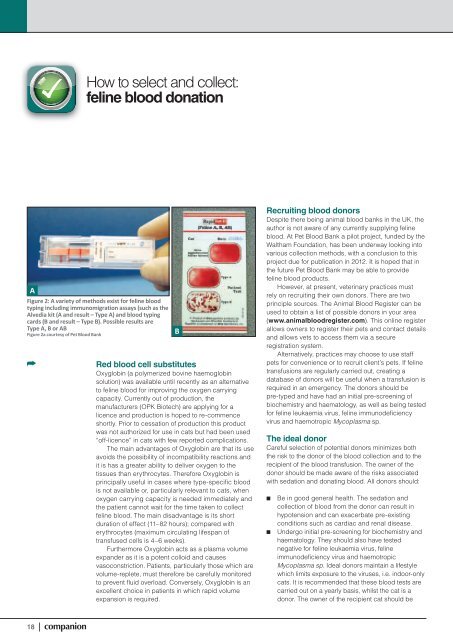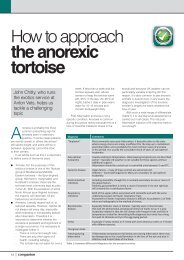Companion May 2012 - BSAVA
Companion May 2012 - BSAVA
Companion May 2012 - BSAVA
You also want an ePaper? Increase the reach of your titles
YUMPU automatically turns print PDFs into web optimized ePapers that Google loves.
A<br />
18 | companion<br />
How to select and collect:<br />
feline blood donation<br />
Figure 2: A variety of methods exist for feline blood<br />
typing including immunomigration assays (such as the<br />
Alvedia kit (A and result – Type A) and blood typing<br />
cards (B and result – Type B). possible results are<br />
Type A, B or AB<br />
Figure 2a courtesy of pet Blood Bank<br />
B<br />
Red blood cell substitutes<br />
Oxyglobin (a polymerized bovine haemoglobin<br />
solution) was available until recently as an alternative<br />
to feline blood for improving the oxygen carrying<br />
capacity. Currently out of production, the<br />
manufacturers (OPK Biotech) are applying for a<br />
licence and production is hoped to re-commence<br />
shortly. Prior to cessation of production this product<br />
was not authorized for use in cats but had been used<br />
“off-licence” in cats with few reported complications.<br />
The main advantages of Oxyglobin are that its use<br />
avoids the possibility of incompatibility reactions and<br />
it is has a greater ability to deliver oxygen to the<br />
tissues than erythrocytes. Therefore Oxyglobin is<br />
principally useful in cases where type-specific blood<br />
is not available or, particularly relevant to cats, when<br />
oxygen carrying capacity is needed immediately and<br />
the patient cannot wait for the time taken to collect<br />
feline blood. The main disadvantage is its short<br />
duration of effect (11–82 hours); compared with<br />
erythrocytes (maximum circulating lifespan of<br />
transfused cells is 4–6 weeks).<br />
Furthermore Oxyglobin acts as a plasma volume<br />
expander as it is a potent colloid and causes<br />
vasoconstriction. Patients, particularly those which are<br />
volume-replete, must therefore be carefully monitored<br />
to prevent fluid overload. Conversely, Oxyglobin is an<br />
excellent choice in patients in which rapid volume<br />
expansion is required.<br />
Recruiting blood donors<br />
Despite there being animal blood banks in the UK, the<br />
author is not aware of any currently supplying feline<br />
blood. At Pet Blood Bank a pilot project, funded by the<br />
Waltham Foundation, has been underway looking into<br />
various collection methods, with a conclusion to this<br />
project due for publication in <strong>2012</strong>. It is hoped that in<br />
the future Pet Blood Bank may be able to provide<br />
feline blood products.<br />
However, at present, veterinary practices must<br />
rely on recruiting their own donors. There are two<br />
principle sources. The Animal Blood Register can be<br />
used to obtain a list of possible donors in your area<br />
(www.animalbloodregister.com). This online register<br />
allows owners to register their pets and contact details<br />
and allows vets to access them via a secure<br />
registration system.<br />
Alternatively, practices may choose to use staff<br />
pets for convenience or to recruit client’s pets. If feline<br />
transfusions are regularly carried out, creating a<br />
database of donors will be useful when a transfusion is<br />
required in an emergency. The donors should be<br />
pre-typed and have had an initial pre-screening of<br />
biochemistry and haematology, as well as being tested<br />
for feline leukaemia virus, feline immunodeficiency<br />
virus and haemotropic Mycoplasma sp.<br />
The ideal donor<br />
Careful selection of potential donors minimizes both<br />
the risk to the donor of the blood collection and to the<br />
recipient of the blood transfusion. The owner of the<br />
donor should be made aware of the risks associated<br />
with sedation and donating blood. All donors should:<br />
■■ Be in good general health. The sedation and<br />
collection of blood from the donor can result in<br />
hypotension and can exacerbate pre-existing<br />
conditions such as cardiac and renal disease.<br />
■■ Undergo initial pre-screening for biochemistry and<br />
haematology. They should also have tested<br />
negative for feline leukaemia virus, feline<br />
immunodeficiency virus and haemotropic<br />
Mycoplasma sp. Ideal donors maintain a lifestyle<br />
which limits exposure to the viruses, i.e. indoor-only<br />
cats. It is recommended that these blood tests are<br />
carried out on a yearly basis, whilst the cat is a<br />
donor. The owner of the recipient cat should be



